Revitalizing Traditional Tasks with 3D Scanning and Reverse Engineering
Reverse engineering is the practice of deconstructing and analyzing a product or equipment to ascertain the ideas involved in its manufacturing, typically with the aim of creating something comparable, according to Merriam-Webster.
This idea has been around for a while; in the past, reverse engineering was mostly utilized in warfare to discover the technological secrets of the enemy. Enigma is a more modern and well-known example, which the Allies cracked during World War Two.
Today, reverse engineering is more frequently used to describe the procedure of transforming the geometry of a physical product into a digital 3D model, going against the grain of a traditional design workflow. However, only relatively recent technology, such 3D scanning, makes it viable to perform this “modern” style of reverse engineering.
Prior to the advent of 3D scanning, traditional reverse engineering required laborious manual work and instruments like callipers. As a result, the variety of applications for reverse engineering was severely constrained, especially in light of the high standards of parts and goods on the market today and the associated expenses.
Even the most complicated parts can have their geometry accurately and quickly captured via 3D scanning. For instance, laser 3D scanning was recently used to capture a massive docking pump in under 20 minutes.
As we examine in the following section, this technology has made it possible to apply reverse engineering in circumstances beyond straightforward benchmarking and component reproduction.
Main applications for 3D scanning and reverse engineering
There are numerous opportunities for product development and manufacture with reverse engineering and 3D scanning. Reverse engineering can be applied in three main ways: to duplicate existing components, to modify existing parts, or to design completely new parts based on an existing environment or item.
1. Recreate and replicate parts
Reproducing broken or worn-out parts that are unavailable from the original supplier or lack sufficient documentation is one of the most common uses for 3D scanners. When working with antique machinery or cars, this issue frequently arises, and using manual reverse engineering tools like calipers to solve it is always difficult.
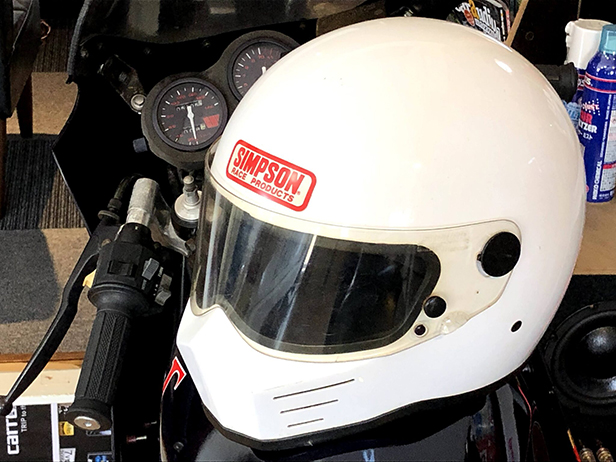
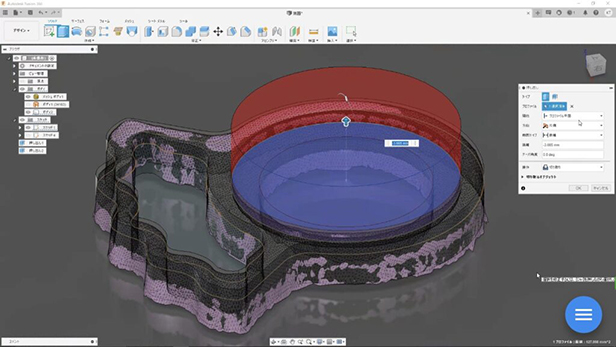
However, it can be made simple with the right software and a good 3D scanner. For instance, Katsuya Tanabiki described how he reverse-engineered a shield notch on an ancient motorcycle helmet. The helmet had two shield notches, but one was broken, and getting a replacement notch was too difficult. With an EinScan Pro 2X in Fixed Mode, this tiny component was 3D scanned and then 3D printed.

Yet, the ultimate result is not usually the part’s actual creation. Reverse engineering is consciously used by the aerospace and automotive sectors, among others, to digitize components and build a digital inventory of legacy parts. “Digital twins” are the name given to these digital components.
Given the complexity of these parts and the tight dimensions criteria and standards they must follow, 3D scanning is essential in this situation. Consider this little turbine that Print3DD reverse-engineered. Without 3D scanning, it would be impossible to correctly duplicate the distinctive geometry of its blades.
2. Improve existing parts
Reverse engineering also aims to develop new and superior varieties rather than just replicating existing products using digital parts.
This process guarantees a flawless fit for components that are a part of bigger assemblies and can greatly minimize the time and expense of producing parts from scratch.
The reverse engineering method of optimizing a pipe utilizing 3D scanning, CAD, and 3D printing has been shown by the Taiwanese business Kiden Design. The uneven geometry of the pipe was recorded by the EinScan Pro HD 3D scanner while it was being used in Handheld mode, and it was afterward patched together in software. The geometry could be easily optimized in CAD because of the precise 3D model that was created.
The customization of furniture elements using 3D scanning and CNC wood carving by Voxel 3D is another excellent example of reverse engineering being utilized to produce new iterations of actual products. In this project, the 3D-scanned carvings from one piece of furniture were digitalized and merged into many pieces.
3. Create entirely new parts
With the advent of 3D scanning, reverse engineering has gained another use, this time to manufacture totally new parts using digitized parts as a reference.
When a tight fit is needed on an existing item that is too complex or has an uneven interface, this approach is typically used.
Let’s examine a use case from the Fuller Moto auto modification business to demonstrate this. Bryan Fuller and his group 3D scanned the complete footwell of a 1967 Lincoln Continental using the EinScan Pro 2X Plus. A new kick panel was created using the digitized area as a guide, and the accurate 3D model of the footwell allowed the new component to fit perfectly in the modified vehicle.
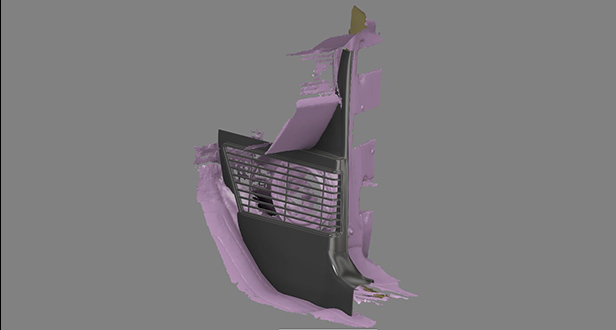
Medical practitioners frequently use this technique as well because body components are distinctive and difficult to copy precisely using manual procedures. Here, 3D scanning has again demonstrated its effectiveness as a technique for digitizing human surfaces and parts.
For instance, earmolds are patient-specific components that assist in transferring sound from hearing aids to the ear canal. Patients may endure hearing issues while waiting weeks for their earmolds to be repaired or made from scratch.
On the other hand, the Hearing Beyond Audiology Clinic in Toronto can make temporary earmolds in just one day thanks to reverse engineering techniques with 3D scanning and 3D printing. While they are waiting for the earmolds to be made or maintained in other facilities, patients can maintain their hearing using the temporary accessory.
Facial prosthetics and personalized orthotics are also made using reverse engineering techniques using 3D scanning.
What makes for a good reverse engineering job?
The aforementioned use cases amply illustrate the crucial part that 3D scanning plays in reverse engineering. It should come as no surprise that a successful reverse engineering process depends on the efficiency and accuracy of the data collected by 3D scanning.
However, the software applications required to analyze the data and manipulate the 3D models are equally crucial for reverse engineering to succeed.
Let’s go over the key steps of reverse engineering with 3D scanning to better appreciate the significance of accurate data and suitable tools.
1. Data acquisition
Data capture is the first stage in any reverse engineering procedure. Whatever the approach, careful planning and preparation can mean the difference between high-quality data and low-quality data.
This is done with 3D scanning by choosing the best tool for the purpose, together with the appropriate configuration (handheld or fixed), and add-ons like turntables, fixtures, and calibration panels. To collect high-quality data, the gadget must be calibrated properly.
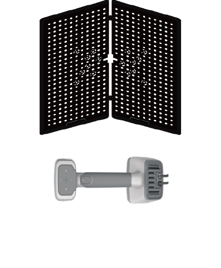
Usually, some type of preparation is required for the regions or components that will be digitalized. Certain 3D scanning systems demand the application of markers or even specific coatings on reflective surfaces in addition to a thorough cleaning.
Before beginning the digitalization process, one should also take the surrounding circumstances into account. To lessen noise in the data, a controlled environment is always desired, but that isn’t always achievable. Examples are inside, out of direct sunlight, on a cleaned surface, etc.
All of the aforementioned elements will help to ensure proper data collection, which in turn will affect how fast and simply the data may be processed after collection.
2. Post-processing
The following stage of reverse engineering involves post-processing the collected data, or “point cloud.” Here, a 3D mesh representation of the digitally captured object is produced after the point cloud has been processed by software tools, such as EinScan software.
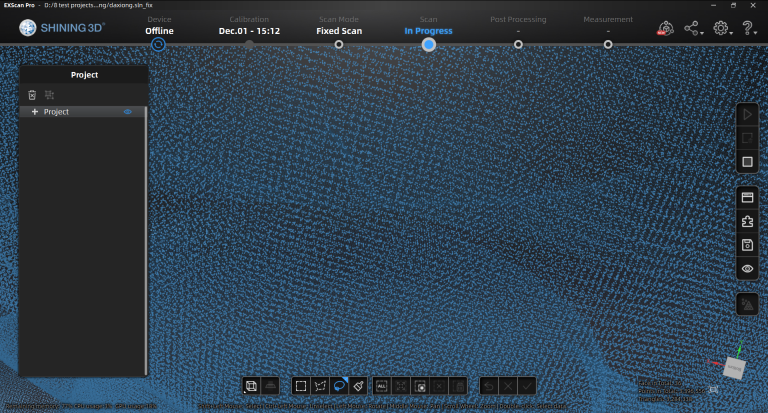
Nonetheless, the 3D model in this preliminary stage typically needs some fine-tuning, such as deleting unneeded recorded data, fixing surfaces, and filling gaps.
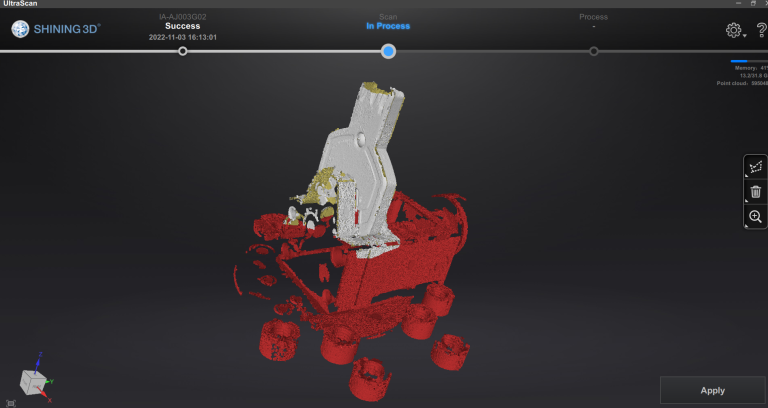
Here, we can see why the data-gathering stage is crucial: the greater the quality of the data, the less post-processing and repair will be required.
Reference entities are also allocated to the 3D model during the post-processing stage, which should hasten the following phase in the reverse engineering process.
3. CAD development
Creating a solid 3D model from the mesh representation of the real object is the last stage in the reverse engineering process.
Despite how precise the mesh model can be, it is insufficient for the majority of reverse engineering applications that call for further processing, such as repairing physical damage, producing variations, or building whole new parts.
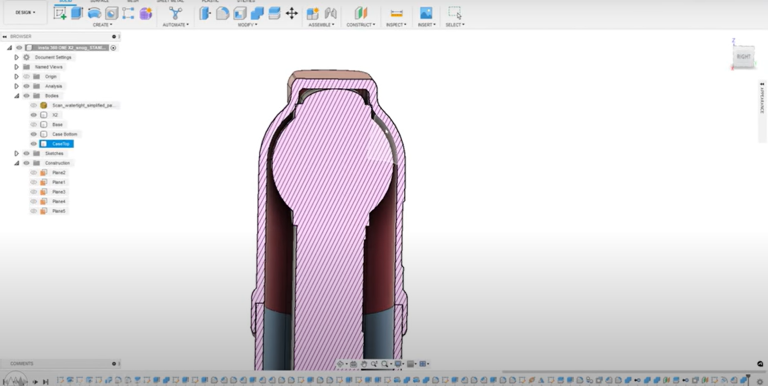
The improved mesh model from the previous stage serves as a precise reference model in this stage so that the model may be recreated using parametric CAD tools.
Although technically any general-purpose CAD application could perform this, reverse engineering-specific tools can make the process more simpler and produce far superior results.
Users can verify geometrical and dimensional variations by comparing the digital model to the parametric one using the proper CAD program for reverse engineering.
Conclusion
The militaristic uses of reverse engineering in the past are a thing of the past. Reverse engineering now has a wider range of industrial applications thanks to 3D scanning technology, which is advantageous to both enterprises and customers.
To get effective results in reverse engineering, the quality of the recorded data is essential. The selection of the 3D scanning tool and its features and functionalities are crucial to the efficiency of the entire procedure.
The software used in the final stages of reverse engineering is very important while being frequently disregarded or undervalued. The right built-in tools for the work can significantly impact how successfully reverse engineering is done.
Click on the following link Metrologically Speaking to read more such blogs on Metrology.









